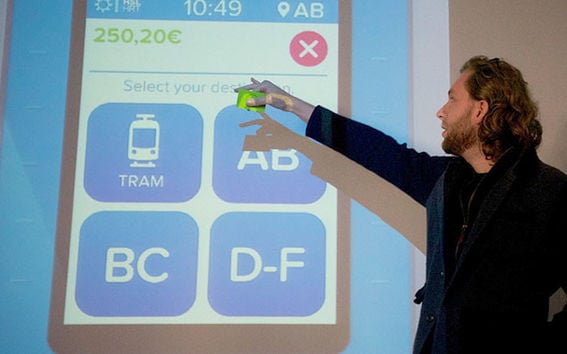Students made suggestions for improvement to the user interface of HSL's new travel card reader

A ticket reader is the first thing travellers notice when stepping into a bus, tram or other forms of public transport. There is only few seconds for pressing buttons. Therefore, the user interface must guide users to eliminate the need for separate instructions or guidance.
The Designing Interactions course is part of the Master's Programme in Collaborative and Industrial Design of Aalto University's Department of Design. This year, the course included a two-week special period on touchscreen devices, which included an exercise where students assessed HSL's new travel card reading devices with touchscreens and developed a future user interface for them. The devices were introduced in the summer of 2016 after five years of development work.
Model of rapid design utilised in the solutions
The leader of the course Severi Uusitalo and the teacher of the special period Harri Heikkilä of School of Arts, Design and Architecture discussed the requirements and boundary conditions of the card reader with HSL. Subsequently, HSL's designers presented the device to the students. Among other things, the instructions included going over the new travel zone model, most important boundary conditions and requirements for designing as well as presenting the device itself. The card reader was loaned to the students for the duration of the course.
'There is an interesting and demanding system behind the travel card reader. The exercise was also good because it was so difficult', explains researcher Harri Heikkilä.
In the course, the aim was to develop a user interface that could be used as intuitively as possible. A method of design specifically intended for touchscreen devices was applied in the work. The method aims to proceed in an agile way from discovering problems to presenting solutions as multiple parallel models using a research-based approach. The method was developed in Aalto University in 2010–2014 as a part of the Next Media project.
A total number of 18 students took part. As a result of two weeks of work, they were able to create versatile solutions in the groups, which were presented as interactive prototypes resembling the final product.
The developed functional models improve, for instance, the visual aspects of the zones on the screen to make it easier to perceive them and, on the other hand, guide the order of using the card and the buttons on the screen more clearly. Additionally, a new, easier way for purchasing group tickets with the device was developed.
Satu Rönnqvist, a project manager at HSL, says that students had completed a huge amount of work in a short time. The proposed solutions are taken into account in the coming further development.
'The solutions are ambitious, and they all included good insights.'
Aalto University's Haplab project has promoted research on user-friendliness of software
The exercise completed in the course was part of Aalto Media Factory's Haplab project which aims to promote the methods of touchscreen design and apply them in teaching.
Heikkilä wants to highlight the fact that touchscreen technology will play an increasingly large role in the ubiquitous society in the future.
'Touchscreens are not just a matter of smartphones or tablets, but they will soon be everywhere; in watches, multimedia screens in museums, cameras and means of transport. The HSL ticket device is only one of their manifestations. It is thus increasingly important to understand the special features and good practices of designing for touchscreens. This is a matter of a new area of design that is essential for digitalisation and has not been paid enough attention.'
http://mediafactory.aalto.fi/haplab/
Haplab has been a two-year (2015–2016) project funded by Finnmedia fund and companies.
Further information:
Harri Heikkilä
tel. +358 400 214 713
Photo: Harri Heikkilä
Text: Annika Artimo
Read more news

Online AI course could boost study equality
Students at the School of Business believe that mastering Artificial Intelligence (AI) can be beneficial for both academic success and career prospects, as AI becomes increasingly integrated into daily life.
2 027 new students admitted to Aalto University’s Finnish, Swedish bachelor’s programmes
13 500 applied to Aalto University in Finland's spring joint application in 2024
Meet the the Program Assistants that elevate the Aalto University Summer School experience for 250 students from all over the world
Each year, the Aalto University Summer School has grown its operations and course curriculum tremendously.